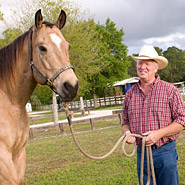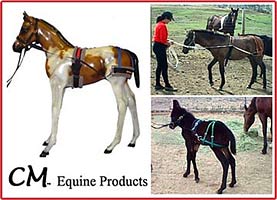 |
 |
|
EARLY FOAL TRAINING 21st Century Tools - Age Old SAVY!
by Marge Spencer CM™ Equine Products
“This is amazing, never saw anything like it”
“He walked around, turned (even disengaged) and just responds beautifully”
“He accepted the system and within a few seconds, understood and walked with me with hardly any pressure on the lines.”
“Wow, how does that thing work?”
Comments like these are what I have been hearing over and over again. Why? With the CM Lead and Drive Training System they were given, all of them were able to take their newborn
foal or weanling and immediately begin communication.
COMMUNICATION (the Age Old Savvy) is the key to success in our personal lives and our
relationships with our pets. The better we get at communication with our equine friends the better horseman we become. If you list the basic concepts of all types of training, better
communication is the one thing all have in common.
Many years ago, Dr. Robert Miller discovered that when he worked with newborn foals with
medical problems they remembered him and were “imprinted” at birth. He developed a system that is known worldwide.
Many clinicians have worked wonders with their training techniques and are extremely skilled in the art of communication. Each has developed unique tools used to help us understand their technique.
Mine are 21st Century terms, the computer terms “Formatting and Programming” Every computer disk needs to be formatted or it is useless, after it has been formatted it can run the
programming we ask. It never forgets the formatting that was done, but the programming we run
can change with our needs. So after the “formatting” is done we can do the “programming” or training of the foal.
The “formatting” process for newborn foals begins at birth, with the images they see, the touching and talking as you work with them and the immediate acceptance of us being part of
their concept of ‘normal’. My method of formatting is to make sure the foal knows we will not harm him and that we ask for the same respect that he learns from the mare.
I am not only an advocate for early training, but first and foremost, safety for the mare, foal and for us. Please do not forget your mare.
Before you begin, make sure your mare will accept you being there, and accept all of those things that you are going to ask her foal to accept.
I would suggest you work with your mare for a couple of weeks before she foals to make sure you are not going to scare her, and if she is a difficult mare, have an assistant handy to halter her
to keep everyone safe. Remember that the mare will teach the foal everything including her attitude, so again, don’t forget the mare.
Whatever method of initial training you choose to use, the foal should accept being touched all over the body, feet and head. It should be able to accept the halter and stand quietly next to
you. My “formatting” process is not done one time only. I do it a minimum of two times within
the first 24 hours and continue for the first three to five days. I find that the first 10-14 days of
the foals life is “formatting” period: if you watch carefully, you will see that the first day they
struggle to get up and find food. Then some get curious and go exploring. Day two could be discovering they can kick mom or even trot.
Each day will bring another learning experience, and by the end of the second week, they have developed their talents for biting, kicking, running and playing that will become a permanent part
of their distinct personality. As I said before, “ don’t forget the mare” and I will repeat this
because you must remember that the other 23 or so hours you are not with this foal the mare is teaching the foal her way. If the mare is a dominant mare, typically the foal will be as well, if the
mare is submissive this is taught to the foal. Knowing the mare’s characteristics and fears that activate her flight response can help you develop a program that will give the best results.
Traditional ways of beginning lead training may include using your arms, using a rope around the rump or other types of body ropes. I used those techniques for many years until I began to think
there must be a better way of COMMUNICATION: The mare doesn’t use those tools and she gets her foal to follow her lead, and if I could speak her language, this foal they would surely understand.
Here is where the 21st Century tools combines with the Ago Old Savvy. I designed and developed an early foal training system called the CM™ Lead and Drive Training System that
can get your foal ready for almost anything we will ask them to do the rest of their lives.
I continue the “formatting” process on the third day of the foal’s life by introducing him to my lead
and drive system. Provided the foal is healthy and has had no problems in the birth. If they are not sound on their legs, I may give them a day or two extra, but as a general rule the third day is
the best to begin.
Remember in the formatting stage I want the foal to accept the halter and stand quietly next to
me. With this in mind you begin to put on the CM™ Lead and Drive Training System starting
with the saddle portion (the saddle is a driving term for the part similar to a surcingle). It is all
right if this takes one full session or 15-20 minutes to accomplish, don't rush. Next comes the breeching section then the lines. The lines are then attached to the breeching, run through the
saddle and from the inside of the foal’s halter to the outside. This will look like a backward driving harness set up. Now you have full control of the foal, from the rear through the neck and
head without any pressure on the poll. Relax and let them get used to all of those parts you are asking him to wear. Lots of rubbing and reassurance would be good here.
Pat Parelli says that horses are claustrophobic and panic-aholic and he is correct. Ever try to get a horse into a wash rack or a trailer for the first time? They look at that small space and say,
“NO WAY I’M GOING IN THERE!” OR you may be riding down the trail and all of a sudden
the horse eating rock appears, panic sets in and the flight reflex says, “ I’M OUT OF HERE!”
With my system you are “formatting” behaviors in your young foal to overcome those fears. The complete control you have from one side of the foal around the rear and back through the other
side simulate enclosure. It is their first lesson involving a controlled stress situation. The system was not made to drag your foal around, but to teach control and ask for a response, using their
language.
Now with all of that “formatted” you are ready to “run some programs”.
First, I must say that some are concerned about over-stressing the foal and think that they should be left alone until weaned. In my opinion this just creates an even bigger chance for harm to the
weanling and to us humans. In the wild, foals are subjected to all types of stress, which the mare teaches them to handle. If your foal is put in a controlled stress position it learns how to cope in
a safe manner. This is part of your challenge in perfecting your skills in communication with your horse. If you do not feel confident please consult someone skilled in working with foals; never
put your foal or yourself in harm’s way.
Acceptance of this system is normally rapid – the baby is and they are relaxed and ready to
follow your lead. Gentle, rhythmic pulls on the lines will produce forward motion almost immediately. There is much, much more you can teach with this system. The best advice I can
give is to repeat; repeat, repeat use the least amount of pressure possible so eventually the suggestion alone would result in movement.
The progression of lessons you can teach your foal using this system leads to learning that is fun for the foal and for you. Take your time, be calm, use only the amount of force necessary to get
a response, and then reward the try. Have fun with your foals while getting them ready for the jobs you expect them to perform when they are older.
You will have created a safe riding animal.
Contact us for more information 1-888-431-7771
2004 CM Equine Products©, all rights reserved
Contact:
Marge or Charlie Spencer
CM™ Equine Products
Norco, California 92860
Phone: 888-431-7771
Email: spencer@cmequineproducts.com
Website: www.cmequineproducts.com/
|
 |
|
To advertise your horse product or service, contact Ann
|
 |
|
InfoHorse.com, Horse Information Lives Here ® 4/16/2024
Contact Us to Advertise to over a million Horse Owners.
All images and content Copyright© 2012 by InfoHorse.com, Equusite.com.
Horse Owners are Dog Owners; Dog Product Information dognowner.com
|
|
|
Articles, Academic Schools, Arena Maintenance, Animal Communicators, Barns, Barn and Accessories, Barn Equipment and Tractors, Breast Collars, Grooming Products for Horses, Hay Feeders, Horse Blankets, Horse Books, Horse Videos, Horse Breeders, Horse Camping Gear, Career Schools, Carts and Buggies, Horse Training Clinicians, Equestrian Clothing, Dogs and Puppies, Horse Fencing, Western Art & Furniture, Horse Property for Sale, Horse Products For Sale, Fly Control, Foal Care, Horse Footings, Horse Gifts, Horse Health and Nutrition, Hoof and Leg, Horse Insurance, John Lyons Certified Trainers, Equine Lawyers, Leather Care, Links
, Horse Property, Horse Photography, Portable Horse Stalls, Arenas and Roundpens, Horse Riding Schools, Horse Schools, Safety Products, Services for Horses, Horse Trailers, Horse Shipping, Horse Skin Coat Care, Horse Software, Specialty Trainers, Horse Summer Camps, Tack, Horse Trainers, Treats and Snacks, Truck Accessories, Trucks, Horse
Vacations, Western Lifestyle, jewelry
|
|
|



